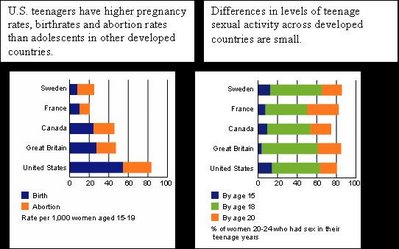The debate over maintaining legalized abortion in America is among the most contentious issues of our day. We would hope that both sides could at least agree that reducing the number of unwanted pregnancies would be the safest route to reducing the rate of abortion. As moderates increase their strength in our government following the midterm 2006 elections we can only hope that reason wins out over zealotry and that data triumphs over dogma.
The following is from the Guttmacher Institute:

• The primary reasons why U.S. teenagers have the highest rates of pregnancy, childbearing and abortion among developed countries is less overall contraceptive use and less use of the pill or other long-acting reversible hormonal methods, which have the highest use-effectiveness rates.
• Factors in cross-country differences in teenagers' contraceptive use include negative societal attitudes toward teenage sexual relationships, restricted access to and high costs of reproductive health services, ambivalence toward contraceptive methods and lack of motivation to delay motherhood or to avoid unintended pregnancy.
• Overall, declines in the adolescent abortion rate between 1980 and 1995 are less prevalent than are declines in the adolescent birthrate. However, the decline in the U.S. teenage abortion rate between 1985 and 1996 was one of the largest in the developed world—the rate decreased by more than one-third (from 46 to 29 per 1,000). Nonetheless, the U.S. adolescent abortion rate remains one of the highest among developed countries.
• Differences in sexual activity and the age at which teenagers become sexually active do not account for the wide variation in pregnancy and STD rates among comparable developed countries, such as Canada, France, Great Britain, Sweden and the United States.
• Strong public support and expectations for the transition to adult economic roles, and for parenthood, provide young people with greater incentives and means to delay childbearing.
• Easy access to contraceptives and other reproductive health services contributes to better contraceptive use and, in turn, low teenage pregnancy rates.

0 Comments:
Post a Comment
<< Home